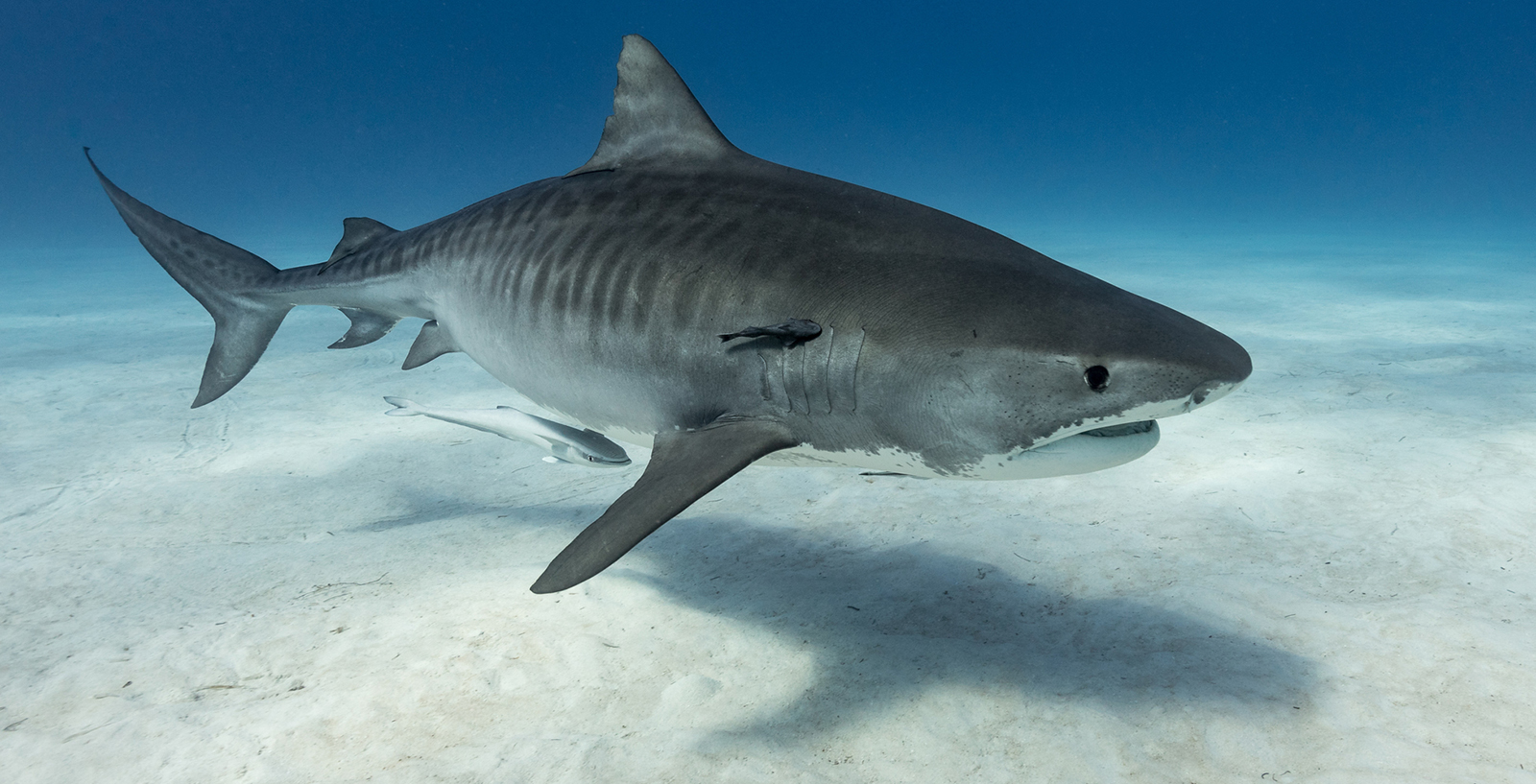Southern New England’s Many Sharks Come In Different Shapes and Sizes
But each species share a single bond: their survival is at risk
March 27, 2024
When southern New England’s marine waters chill for the winter, most of the region’s large sharks leave for warmer destinations, while another one stays or arrives — the porbeagle.
This shark, with a white or light gray free rear tip of its dorsal fin, prefers colder water. Like other sharks in its family — Lamnidae, commonly called the mackerel sharks — the porbeagle (Lamna nasus) can raise its body temperature almost 20 degrees above surrounding water temperatures. They can get as large as 10-plus feet long and weigh 300 or so pounds.
“The porbeagle is much less known than their close relatives the white shark and the mako, but it’s a gorgeous and formidable shark that is truly New England’s year-round bruiser,” Jon Dodd, executive director of the South Kingstown, R.I.-based Atlantic Shark Institute, said in early February after a porbeagle was found on a Watch Hill beach.
The mature female porbeagle was 8 feet, 8 inches long and weighed several hundred pounds. There were no signs of trauma, and a necropsy was performed. A cause of death couldn’t be confirmed, but she had been pregnant and given birth, according to Dodd.
The name porbeagle is derived from the Cornish “porgh-bugel,” and likely comes from a combination of “porpoise,” referring to its shape, and “beagle,” referring to its hunting prowess.
In the past, porbeagles were considered a nuisance because of the damage they often caused to fishing gear. Today, there are regulated Norwegian and Canadian fisheries for porbeagles in the North Atlantic.
The porbeagle is a significant bycatch species, the second-most common, for example, in the Norwegian fishery and they are commonly caught as bycatch by Japanese longliners.
Besides being harvested for human consumption, mostly for shark fin soup, porbeagles are also killed for their oil and to make fertilizer.
The International Union for Conservation of Nature’s (IUCN) Red List of Threatened Species lists the porbeagle as vulnerable worldwide.
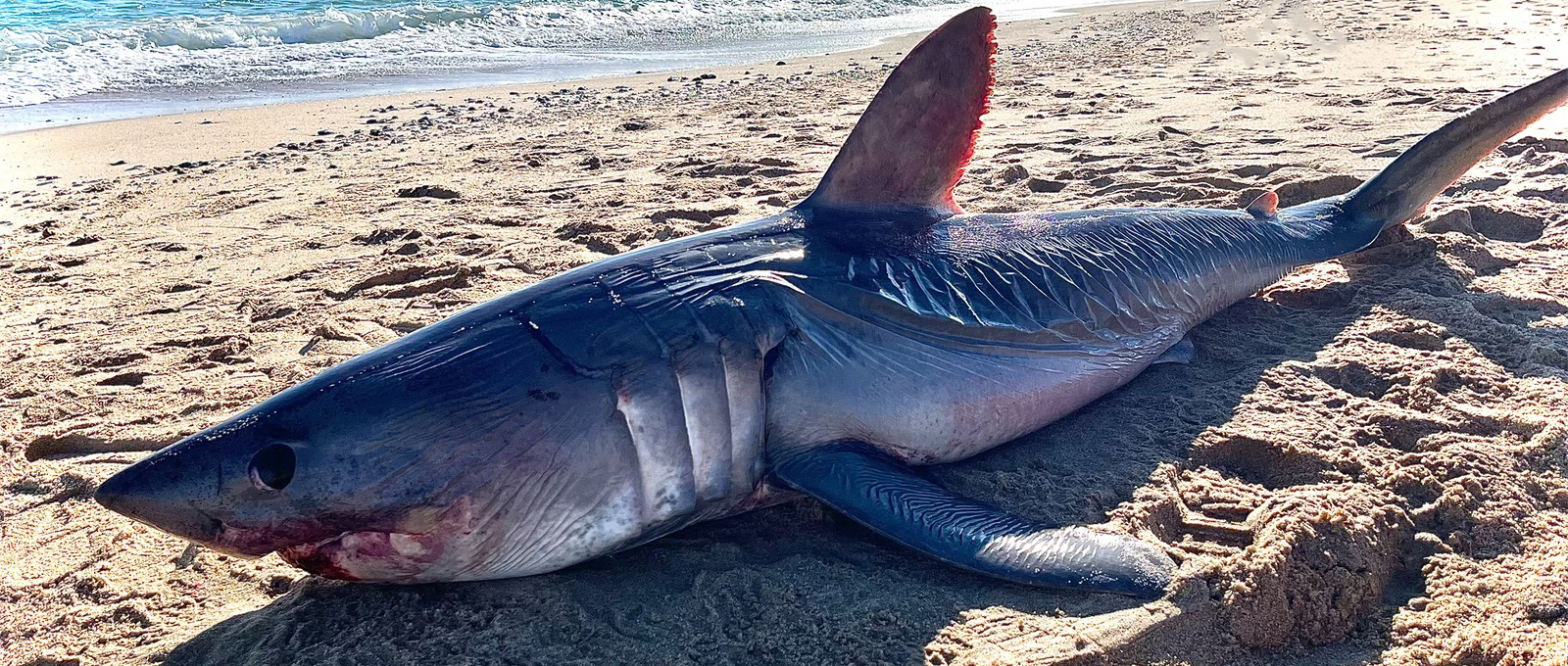
The Atlantic Shark Institute monitors blacktip, blue, common thresher, porbeagle, shortfin mako, white, and now spinner sharks.
“I remember catching a spinner a few years ago and telling some folks older than me that have been out of the business but are preeminent, sharp researchers, ‘Hey, look what I caught,’ and they were like, ‘Hey, where are you in Florida?’ And I’m like, ‘No, I’m off Montauk.’ And they’re like, ‘No, no, no, no, this cannot be where you are because they’re not up here,’” Dodd recalled during an online conversation with ecoRI News last week.
The 62-year-old co-founder of the Atlantic Shark Institute has since tagged eight other spinners he has caught in local waters. They can now be found here because New England has the fastest increasing sea temperatures in the country, up 3 degrees in the past century-plus, according to Dodd.
The porbeagle isn’t the only mackerel shark swimming in local waters. The others include:
Atlantic common thresher. This oceanic shark is rarely seen near shore, and can jump out of the water if provoked or threatened. They can grow to be 16 or so feet long, but about half that length is tail. Their tails alone can weigh up to 1,000 or so pounds. They have been observed to use their long tails to herd, disorient, and stun prey. They can live a long time (20-50 years), reproduce late in life, and only have a few young at a time. Their range is large. They are often caught on longlines hooked by the tail.
Interesting fact: They have about 50 rows of teeth, with sharp triangular teeth ideal to catch small prey. IUCN Red List: Vulnerable.
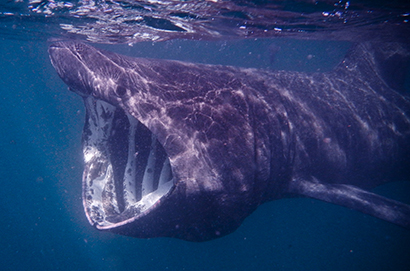
Basking. This oceanic shark is a filter feeder, swimming with its mouth open as water — filled with plankton, small fish, and fish eggs — flows through. An adult can process more than 1,500 gallons of water an hour. These sharks have hundreds of tiny teeth. They can grow to be 45 feet in length and can weigh up to 4 tons. It’s the second-largest fish, after the whale shark. They have low reproductive rates and are one of the more vulnerable species to overfishing. They are slow swimmers, going no more than 3 mph. They have large individual home ranges and don’t stay in any one place for longer than a few months. They are fished for their liver oil, meat, and fins.
Interesting fact: They have been observed leaping out of the water, which may be a way of getting rid of parasites. IUCN Red List: Vulnerable.
Sand tiger. Also known as the gray nurse shark, this slow-swimming coastal species is closely related to white and mako sharks. They can grow to be 10.5 feet long and weigh 650 or so pounds. Although this species isn’t widely fished for food, it has one of the lowest reproduction rates of all sharks because of intrauterine cannibalism, in which eggs and developing embryos are eaten by the largest embryo until only one remains.
Interesting fact: They are the only shark that is known to maintain neutral buoyancy by gulping air at the water’s surface and holding it in its stomach. This allows the sand tiger shark to hover motionless in the water. IUCN Red List: Critically endangered.
Shortfin mako. This oceanic species is the fastest shark and one of the fastest fishes on the planet, with speeds up to 45 mph. Sometimes known as the blue pointer, they can grow to be 13 feet in length and weigh 1,500 pounds. They are rarely found close to land and are known to travel great distances to feed and mate. They are a common bycatch in the tuna and swordfish fisheries. Females reach sexual maturity around 21 years old. They can be found 15-50 miles offshore of the southern New England coast from June to October/November.
Interesting fact: Their athleticism is not restricted to their swimming speeds. They are also known for their incredible leaping ability and can be observed jumping to extreme heights when hunting. IUCN Red List: Endangered.
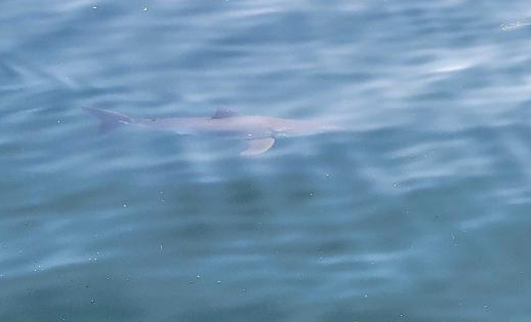
White. Better known as the great white shark, these media darlings are named for their stark white underbellies. Females can reach lengths of 21 or so feet and weigh up to 2-plus tons. Males are slightly smaller. They are the third-largest shark after the whale and basking. Females reach sexual maturity around 33 years old, with males reaching maturity at 26. Females give live birth to their pups, with litter sizes ranging from 4-12 individuals. A white shark pup is about 4 feet long when born. They reproduce slowly, with a female giving birth only once about every 3 years. They have an amazing sense of smell that can find a drop of blood in 100 liters of water. They can even stick their head out of the water to smell the air and find prey such as seals.
In Rhode Island, they have been sighted off Block Island and Point Judith. Dodd said smaller, younger white sharks are found more often in Rhode Island waters, where they feed on sea bass, striped bass, and dogfish, the Ocean State’s most numerous shark species. He said bigger, mature white sharks are more likely to be drawn to the waters off Cape Cod, where they can feed on seals that can weigh 900 or so pounds.
Interesting fact: During hunts, their eyes roll backwards to protect the cornea from thrashing animals. IUCN Red List: Vulnerable.
Sharks are uniquely distinguished from other fish by their cartilaginous skeleton, five to seven gill slits, and sandpaper-like scales. They have evolved over 400 million years and the modern species have changed little since the time of the dinosaurs. The evolutionary success of these animals can be attributed to their unique adaptations. They possess at least six senses finely tuned to navigate, communicate, and detect prey. Their multiple rows of sharp teeth are replaced continually to ensure efficiency.
Shark populations are also slow to replenish, because many sharks don’t reach sexual maturity for 30 or so years.
There are some 500 species of sharks worldwide, and they range in size from the 8-inch dwarf lanternshark to the school bus-sized whale shark. Their habitat ranges from coastal areas to the open ocean, from Arctic waters to tropical seas, from surface waters to abyssal depths.
Lamnidaes, however, aren’t the only sharks that can be found in southern New England waters. Here is a look at the others:
Blue. These oceanic sharks (in video above) are long and skinny and can grow to be 12 feet in length and weigh 450 pounds. They are excellent swimmers. Mating between males and females is violent, as the males often bite the females. To withstand the violence of mating, the female’s skin is three times as thick as that of their male counterparts. Although not good to eat, blues are the world’s most fished shark species. They are harvested for their fins, skin, and tails. Their teeth and jaws are also harvested for commercial uses.
Interesting fact: They are one of the most wide-ranging shark species, and can be found throughout all oceans, in both temperate and tropical waters, from the surface down to depths of 3,300 feet. IUCN Red List: Near threatened.
Blacktip. This shark features black-tipped pectoral, dorsal, and tail fins. They live in coastal waters off beaches, over coral reefs, and in bays and estuaries. They are a migratory species and usually aggregate in small schools segregated by gender. On average, they grow to about 6.5 feet and weigh about 140 pounds, with females growing larger than males.
Interesting fact: They have an excellent sense of smell and can detect one part of fish flesh in 10 billion parts of seawater. IUCN Red List: Vulnerable.
Dusky. This coastal species are long-distance swimmers known for seasonal migrations. These sharks can live up to 50 years, but they are slow to grow and to reproduce. They can reach a length of 12 feet and weigh up to 400 pounds. Catches of dusky sharks have been prohibited in both U.S. commercial and recreational fisheries since 2000, although they are often caught as bycatch. They are very slow growing, mature late, and have small litters.
Interesting fact: They make large-scale seasonal migrations, often covering thousands of miles per migration. IUCN Red List: Vulnerable.
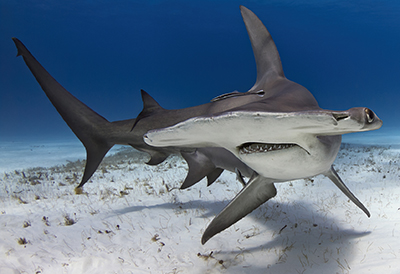
Great hammerhead. This tropical species makes an occasional appearance during the region’s warmest months. They are the largest of the nine hammerhead species, reaching an average length of 13 feet and weight of 500 pounds. Their wide-set eyes give them a better visual range, and by spreading their highly specialized sensory organs across their mallet-shaped heads, they can more thoroughly scan for prey. Their populations have suffered tremendous commercial fishing pressure from both target and bycatch fisheries.
Interesting fact: Females give birth to live young – anywhere from 6 to 42 pups – once every two years. IUCN Red List: Critically endangered.
Sandbar. This coastal shark species migrates to the region in the summer. They can grow to be 8 feet long and weigh 200 pounds. They are often found in harbors, bays, and the mouths of rivers, as they prefer protected waters with smooth, sandy bottoms. A small number of permitted vessels in the U.S. Atlantic Ocean and Gulf of Mexico fish for sandbar sharks for research purposes. All other landings have been prohibited since 2008.
Interesting fact: They are one of the largest shark species that can be found routinely in coastal waters. IUCN Red List: Endangered.
Spinner. This shark species is most common from North Carolina to the Gulf of Mexico. They are easily confused with the blacktip shark, but the blacktip counterintuitively lacks a black tip on its anal fin. The spinner shark has a black tip on its anal fin. They can grow to be 8 feet or so long and weigh 120-plus pounds.
Interesting fact: They are named for their habit of leaping out of the water (up to 20 feet) and rotating up to three times in the air before falling back into the sea. IUCN Red List: Vulnerable.
Spiny, smooth, and chain dogfish. Despite sharing the same surname, this trio of coastal shark species aren’t closely related. At 1.5 feet, the chain dogfish is the smallest of the local trio. Spiny dogfish males grow up to 3.5 feet and females grow up to 4 feet, with a maximum weight of 22 pounds. Smooth dogfish are similar in size and weight to their spiny cousins. Millions of pounds of spiny dogfish are harvested here annually, frozen, and sent overseas to be used in United Kingdom and Europe fish and chips. The Atlantic spiny dogfish fishery is the largest shark fishery in the United States.
Interesting fact: Spiny dogfish are voracious predators while smooth and chain are both primarily scavengers. IUCN Red List: Spiny and smooth are listed as vulnerable while chain is listed as least concern.
Tiger. This tropical species passes through local waters in the summer. Reaching lengths of at least 18 feet and weighting 2,000 pounds, the tiger is the fourth-largest shark and second-largest predatory shark, behind only the white shark. They are named for the dark, vertical stripes found on juveniles. As the sharks mature, the lines begin to fade. Tiger sharks have sharp, highly serrated teeth and powerful jaws that allow them to crack the shells of sea turtles. They have extremely low reproduction rates. Their reputation as a species that bites people (though very rarely) makes them a target of population control efforts in some places, a practice that isn’t supported by scientists.
Interesting fact: After they are born, young tiger sharks are already natural predators, and they eat coastal fishes and invertebrates. IUCN Red List: Near threatened.
